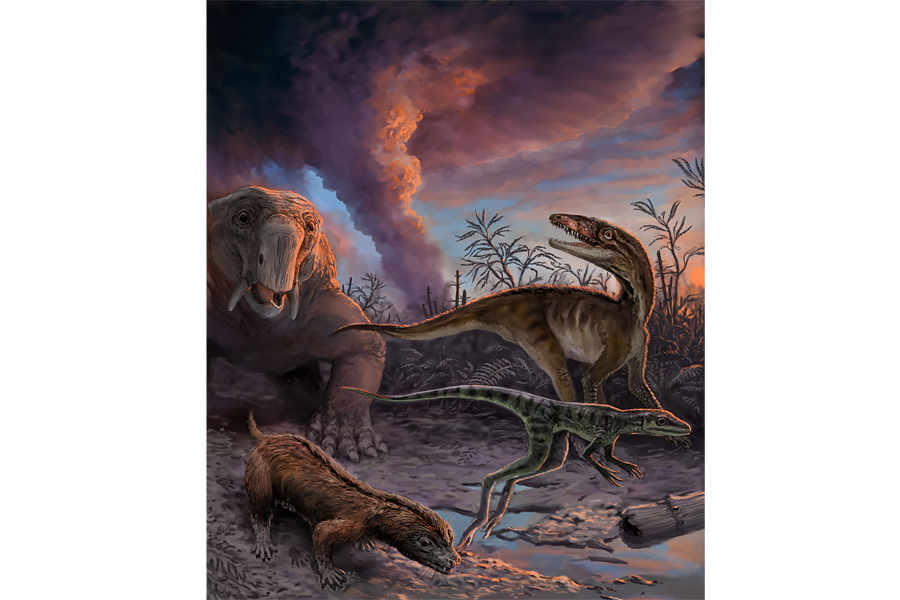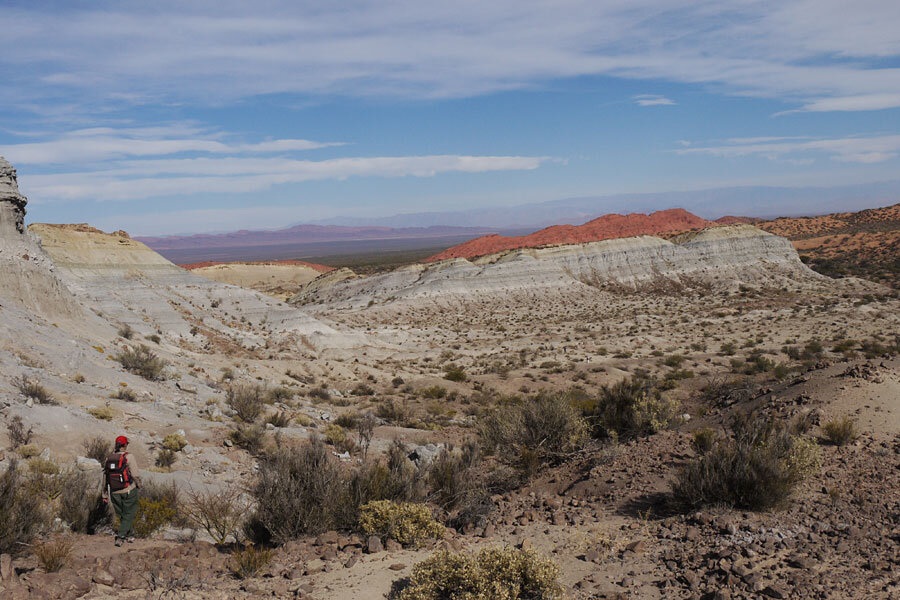Dinosaurs' early cousins may have lived more recently than we thought
Loading...
Before the dinosaurs roamed the Earth, their cousins were here.
Scientists thought these ancient reptiles, creatures that resembled dinosaurs but lacked some of their distinctive characteristics, appeared on our planet by 245 million years ago, but they now may have to rethink that age.
New research reveals that these dinosaur relatives may have been younger than previously thought, situating them much closer to the first dinosaurs.
Some 236 to 234 million years ago, these early dinosaur cousins came onto the scene, with the first dinosaurs following just 5 million years behind, around 231 million years ago, according to the new paper published Monday in the journal Proceedings of the National Academy of Sciences.
Constraining that age could help scientists answer longstanding questions about the origins and success of the dinosaurs.
"It’s still quite poorly understood how dinosaurs themselves originated and how dinosaurs evolved from their closest cousins and when that happened and where that happened and what those closest cousins were like," University of Edinburgh paleontologist and evolutionary biologist Steve Brusatte, who was not involved in the study, tells The Christian Science Monitor in an interview.
Finding out when exactly dinosaur cousins appeared could help explain the emergence of the dinosaurs themselves.
This research will "probably cause a lot of us that work on early dinosaurs to rethink some of our ideas about where dinosaurs came from," Dr. Brusatte says.
Fossils of dinosaur cousins have been discovered at various sites across the globe. One site in Argentina, the Chañares Formation, is especially famous among paleontologists for its fossils. The site was thought to harbor treasures from the Middle Triassic period.
But scientists used dating techniques to find a more precise age for the rocks containing troves of fossils. This is how they found that the fossils are actually from the Late Triassic period, closer to the dawn of the dinosaurs.
Dinosaurs and their cousins in question fall into the clade dinosauromorpha. In terms of timing, these relatives are akin to aunts, uncles and cousins, says study co-author Randall Irmis, curator of paleontology at the Natural History Museum of Utah and an associate professor in the department of geology and geophysics at the University of Utah.
"Sometimes you come after your aunt and uncle, but you also live alongside your cousins," Dr. Irmis explains in an interview with the Monitor. These early dinosauromorphs predated the dinosaurs but also lived into the age of the dinosaurs too. Irmis explains that these animals are known to have lived at least until 210 million years ago, but no later than the end of the Triassic at 201 million years ago.
The early dinosauromorphs aren't the direct lineage that gave rise to the dinosaurs. "They share a common ancestor but they weren't the direct ancestors of the dinosaurs," Irmis says.
Maybe not so special after all
The early dinosauromorphs and the first dinosaurs likely weren't all that much different. Not only did the animals show up around the same time, they also would have looked very similar.
Both animals were relatively small, "had upright posture, their legs underneath their body, running around on two feet, mostly carnivorous, and anywhere from a couple feet to maybe six feet in length," Irmis describes.
"If you saw one in a dark alley, you wouldn’t be able to tell which one was the dinosaur and which was the dinosaur precursor," he says. "You'd be hard pressed in life to be able to tell which was the dinosaur."
It wasn't just the animals' appearances that made them relatively indistinguishable. "It looks like both these early dinosaur precursors and the first dinosaurs were playing very similar roles in their ecosystems," Irmis says. If so, "there wasn’t something really special about the first dinosaurs when they show up on the scene, they’re doing pretty similar things."
Are they really a different animal?
Paleontologists distinguish between the ancient animals from physical markers, like bumps or grooves, on the fossilized bones.
The easiest difference to spot, says Irmis, is in the hip joint. "The dinosaurs themselves have a hole in their hip-sockets, so where the leg-bone fits into the hip, there’s a complete hole through the bone, whereas in the dinosaur precursors and the other reptiles, there’s just a shallow depression as opposed to a hole," Irmis says.
But other than these indicators in the bone, the animals are remarkably difficult to distinguish from one another. Furthermore, "The more fossils we find, the more the line becomes blurred," Irmis says.
With the early dinosauromorphs and first dinosaurs playing similar ecological roles, Irmis suggests that scientists consider the whole clade when asking questions about the origins and success of the dinosaurs.
"If you have a group that goes on to dominate for millions of years like dinosaurs, it doesn’t really mean that when they show up on the scene there’s something special about them," Irmis says. Considering all the dinosauromorphs together, Irmis says, might help scientists find more accurate clues into the success of the ancient reptiles.
A rise to domination
Dinosaurs didn't rule the Earth from the second they arrived on the scene. Instead, it took some 10 to 15 million years more for the the animals to dominate any region.
Scientists are still puzzling over the environmental factors that led to the rise of the dinosaurs. Often, new animals emerge from climatic changes as species evolve and adapt to a changing ecosystem.
But Irmis isn't quite sure how climate could have played a role. "We know that there were changes in climate and the environment throughout the Triassic," he says. "But there's no evidence that they're really associated with the appearance of the dinosaurs."
What the scientists do know, Irmis says, is that dinosaurs flourished first in the higher latitudes where it was more temperate and humid than the hot, dry regions elsewhere.
The dinosauromorph fossils unearthed at the Chañares Formation in Argentina would have been among those in the cooler regions where dinosaurs first rose to dominate.
When these early dinosauromorphs roamed the Earth it would have looked quite different from today. At the time, the main landmasses were stuck together in one super-continent called Pangea. It was also a time when animals were living in a hothouse world in which there were no polar ice caps. It was likely quite warm worldwide.
In what is present-day Argentina, the cooler, more humid air would have blanketed diverse forests with lazy rivers and streams wending their way through the landscape.
Clues trapped in ancient rocks
The Chañares Formation is made up of sediments deposited by rivers and other bodies of water during the Triassic period. Those sediments trapped elements that allowed researchers to find this new date for the fossils found in the rock formation.
"There are some types of minerals that, when they crystalize, they only trap certain radioactive elements," Irmis explains. In the mineral zircon, only uranium is trapped in the crystal lattice as the mineral crystalizes.
The radioactive uranium decays in the crystal over time, producing lead. Because scientists know the rate that uranium decays into lead, they can look at the ratio of uranium to lead in a zircon crystal and calculate when the crystal formed.
"Zircons come from a variety of sources, but the main source that we’re interested in is the volcanic ash that erupts from volcanoes. When we’re lucky, that volcanic ash gets deposited on the landscape and then buried by sediment. So if we can find volcanic ash layers mixed in with the sediments that preserved the fossils, we can then extract zircon," Irmis explains. "So that’s what we did."
Paul Renne, director of the Berkeley Geochronology Center who is not directly affiliated with the study, says that the dates could in fact be younger than Irmis and his colleagues report.
The youngest aged zircon found in the sediments is the closest estimate to determine when the sediment settled to the ground over and around the fossils. Because the zircon could have crystalized before finding its final resting place in the Chañares Formation, these early dinosaur cousins may in fact be younger than even these new findings report, Dr. Renne says.
"Those crystals might have been erupted from another volcano a million years before and it just took some time for them to be deposited down into the basin where the fossils accumulated," Renne explains in an interview with the Monitor.
Irmis isn't so sure that's a concern. "It's unlikely to be any younger because we have dinosauromorphs in the formation and our dates come from both the fossil level and above the fossil level, so that brackets it quite well."
Lingering global questions
"But on the other hand, you have to also ask yourself, are there not possibly older fossils or were there not older animals at more or less the same evolutionary stage that predated this and we just haven't found them?" Renne says.
"It's difficult to prove that you have the first appearance of something, especially when it's a very large vertebrate fossil because the population statistics for dinosaurs are just terrible," he says.
As such, there is much more research to be done on similar sites globally.
"This is one collection of some of the closest dinosaur cousins," Brusatte says. "There's others in the world." The younger dates of the Chañares Formation raises the question of the ages of other sites. Brusatte describes the paper as "thought-provoking" and expects to see more research emerge in response.
Dating these other sites may be challenging, says Renne. "A lot of the environments and locations where these early dinosaurs were found tend not to be in areas of very active volcanism, so we don't have a lot of these time-markers available," he explains.
Irmis says the Chañares Formation fossils may not be the earliest. "There is still a chance that maybe one of these other formations that haven't been dated yet that have early dinosauromorphs could be older," he says. "But I think it's pretty clear that these animals are around by 236 million years ago."









